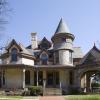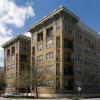The mission of the Raleigh Historic Development Commission is to identify, preserve, protect, and promote Raleigh’s historic resources.
Our Mission
Early Development, Prior to 1830, Antebellum and Civil War Period, 1831-1865, Late Nineteenth Century,1866-1899, Early Twentieth Century, 1900-1945, Late Twentieth Century, 1946-1999, Commercial, Industrial, Residential, Institutional
Displaying All Landmarks
Displaying Landmarks For All Types
Displaying Landmarks For All Periods
Cameron-Maynard-Gatling House
Submitted by Anonymous on Wed, 01/30/2013 - 10:46am
Street Address:
504 East Jones Street
Date:
ca. 1860-1865 Capehart House
Submitted by gshupe on Thu, 08/11/2011 - 7:30pm
Street Address:
424 North Blount Street
Date:
1898 Capital Apartments
Submitted by gshupe on Thu, 08/11/2011 - 8:59pm
Street Address:
127 New Bern Avenue
Date:
1917 Capital Club Building
Submitted by gshupe on Thu, 08/11/2011 - 7:50pm
Street Address:
16 West Martin Street
Date:
1929-1930 Caraleigh Mills
Submitted by gshupe on Thu, 08/11/2011 - 3:13pm
Street Address:
421 Maywood Avenue
Date:
1892, expanded ca. 1900, ca. 1910, ca. 1919, and in the 1950s Carey J. Hunter House
Submitted by gshupe on Thu, 08/11/2011 - 7:22pm
Street Address:
400 North Person Street
Date:
ca. 1882, ca. 1900 Carolina Pines Hotel
Submitted by gshupe on Thu, 08/11/2011 - 7:51pm
Street Address:
1526 Tryon Road
Date:
1933, ca. 1950 Carolina Trust/Mahler Buildings
Submitted by gshupe on Thu, 08/11/2011 - 3:11pm
Street Address:
230 and 228 Fayetteville Street
Date:
1902 and 1876, respectively Carousel at Pullen Park
Submitted by gshupe on Thu, 08/11/2011 - 8:14pm
Street Address:
Pullen Park
Date:
Before 1912 Chapel, St. Augustine College
Submitted by gshupe on Thu, 08/11/2011 - 3:26pm
Street Address:
1315 Oakwood Avenue (Saint Augustine's College Campus)
Date:
1895 








